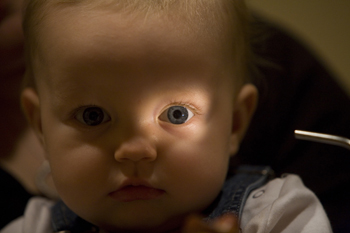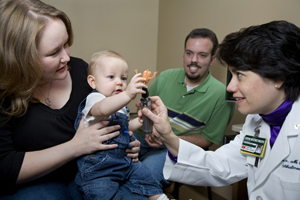
Patient Sullivan Pardee is being treated for congenital glaucoma at the Vanderbilt Eye Institute. (photo by Joe Howell)
Sights set on easing congenital glaucoma

Karen Joos, M.D., Ph.D., with Sullivan Pardee and his parents, Tracy and Tyson. (photo by Joe Howell)
Parents of newborns often are told that their baby has big, beautiful eyes.
It's a common compliment, but it's one that a Vanderbilt ophthalmologist cautions could be a warning sign for congenital glaucoma.
“When the pressure in the eye is high, the eyes enlarge,” said Karen Joos, M.D., Ph.D., associate professor of Ophthalmology at the Vanderbilt Eye Institute. “A child may also show signs of light sensitivity and a cloudiness of the cornea. Sometimes these are subtle changes that can easily be missed.”
Congenital glaucoma is a rare condition affecting one in 10,000 births. Sullivan Pardee, 8 months, is one of those cases. Thankfully his mother, Tracy, noticed a change in his eyes when he was about 3 months old.
According to Joos, the best prognosis is found in patients whose symptoms develop between the age of 3 and 12 months, while those occurring earlier than 3 months typically experience more severe signs of the disease and a tougher outcome.
Pardee noticed several things about her son's left eye — it appeared to be growing larger and darkening and he was sensitive to both sunlight and fluorescent lighting. She began to worry. Alone in her feeling that something was not right with her son's eyes, Pardee followed her instincts and found an ophthalmologist who could see him immediately. Ironically, en route to the doctor, she got a call from her mother.
“I remember driving and being so mad at my mother. She was telling me about a disease she found online that involved all of Sullivan's symptoms — infantile glaucoma. I could not believe she was bringing up something so detrimental. But I mentioned it to the doctor and she agreed it could be a possibility.”
Sullivan was quickly scheduled to see Joos, but before making that appointment he was whisked to the emergency room at Monroe Carell Jr. Children's Hospital at Vanderbilt.
“We woke up the next morning and my husband, Tyson, looked at Sullivan,” said Pardee. “His eye was totally clouded over. It looked like someone had spilled milk in it. The pressure in his eye had built up so high, it burst the membrane that covers and protects the iris.”
Within three days, Sullivan underwent a goniotomy in both eyes to remove the fluid buildup caused by the improper development of the eye's drainage channels. Because the channels were defective, fluid was continually produced with no way to exit. This caused high pressure inside the eye.
Nearly 75 percent of congenital glaucoma cases occur in both eyes and is most often seen in boys (65 percent).
A second surgery was performed a few weeks later because the pressure in Sullivan's eye did not decrease as much as Joos hoped.
The success rate for congenital glaucoma is about 90 percent for up to five years. Clearing the eyes of the drainage obstruction in turn relieved the intraocular pressure in the eyes. This also helped decrease the enlargement of the cornea.
“He has clear, clear eyes,” said Pardee. “His pressures are where they should be. He has two itty-bitty white dots on the edge of his iris, which is the extent of his scarring.
“It used to bother me when someone commented on how big and beautiful his eyes were,” Pardee continued. “I would tell them it was because he had glaucoma. But I stopped doing that now.”
Pardee is thankful for her gut instincts and for the expertise she found at VEI.
“Dr. Joos told me that children 30 years ago would end up in schools for the blind because there were no treatments and the children were not functional in public schools.”
Joos said the surgical procedure was not a cure for Sullivan, as there is no cure for glaucoma. But advancements in therapy are increasing.
Sullivan, who does not require eye drops to lower pressures in his eyes, will continue to see Joos every three months to monitor his progress.













